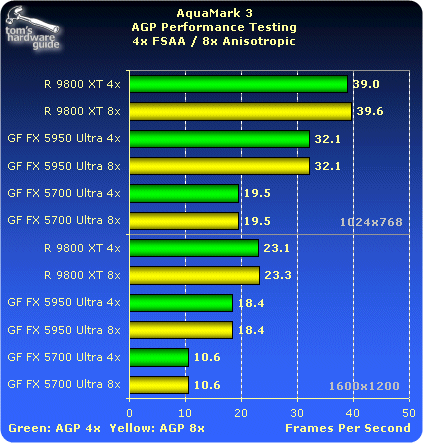Future Promise for Graphics: PCI Express
PCI Express, Continued
Same results at higher quality with FSAA and Anisotropic filtering.
| Header Cell - Column 0 | NVIDIA GeForce FX 5700 | NVIDIA GeForce FX 5950U | ATI Radeon 9800 XT | |||
|---|---|---|---|---|---|---|
| Row 0 - Cell 0 | AGP 4x | AGP 8x | AGP 4x | AGP 8x | AGP 4x | AGP 8x |
| 3dsmax-02 | 17.22 | 17.11 | 17.45 | 17.67 | 13.88 | 13.93 |
| drv-09 | 63.55 | 64.13 | 68.44 | 68.84 | 35.23 | 35.15 |
| dx-08 | 90.81 | 90.91 | 94.23 | 94.24 | 82.16 | 83.69 |
| light-06 | 16.61 | 16.65 | 16.72 | 16.72 | 15.81 | 15.87 |
| proe-02 | 17.18 | 17.73 | 17.4 | 18.22 | 14.56 | 14.66 |
| ugs-03 | 9.41 | 9.41 | 9.46 | 9.46 | 22.95 | 22.96 |
If we can't find any significant differences between AGP 4x and 8x in games, then we might be able to find some in 3D Workstation applications. As you can see, this is not the case. The FX 5950U is a little bit faster in proe-02 when running at AGP 8x but that's all.
Conclusion? The tests show that there's no real difference in today's applications between AGP 4x and 8x. So if we can't see any difference between 1 GB/s and 2 GB/s bandwidth, then you really won't find any improvements if you scale it to 4 GB/s with PCI Express. Maybe different latency times of the buses can make a difference but it looks like PCI Express won't accelerate anything for graphics.
Get Tom's Hardware's best news and in-depth reviews, straight to your inbox.
Current page: PCI Express, Continued
Prev Page PCI Express, Continued Next Page PCI Express, Continued